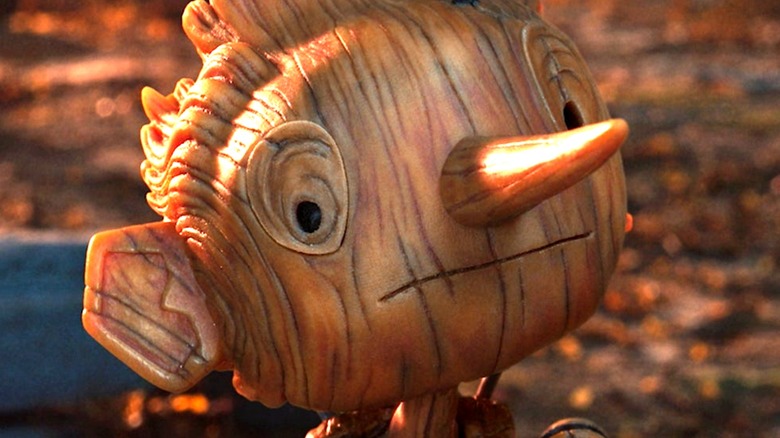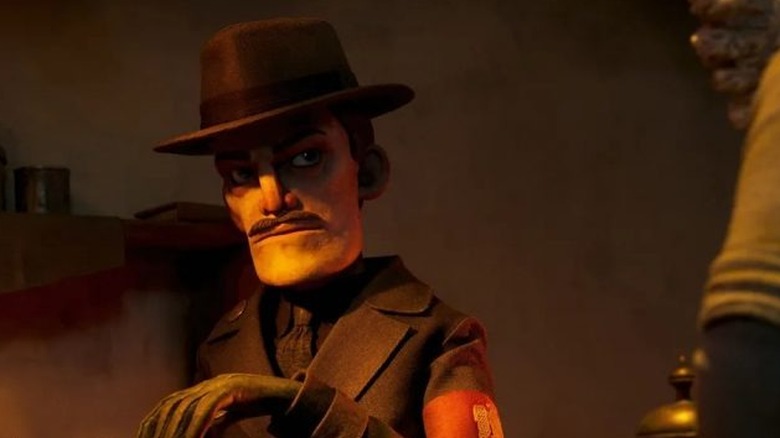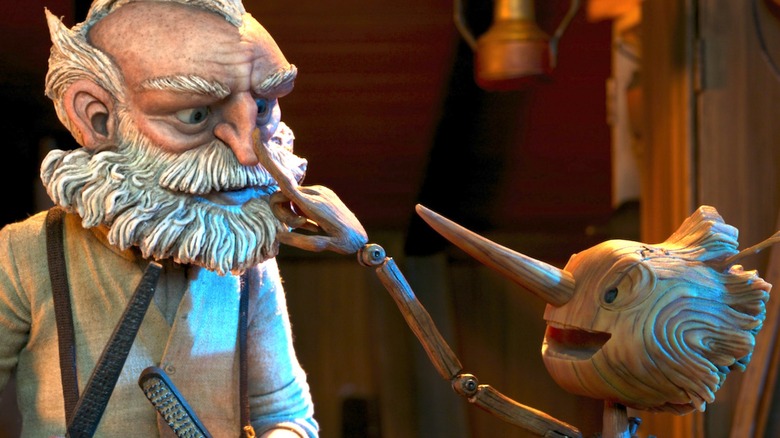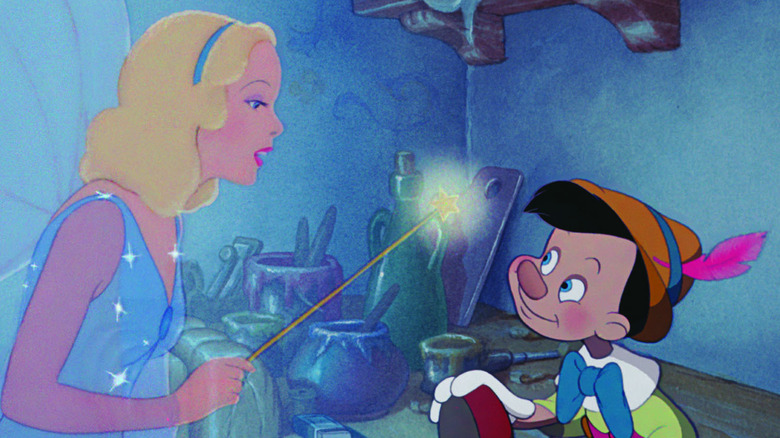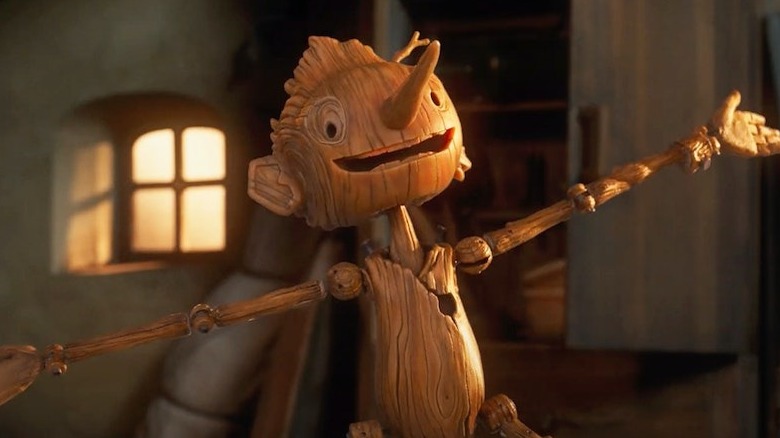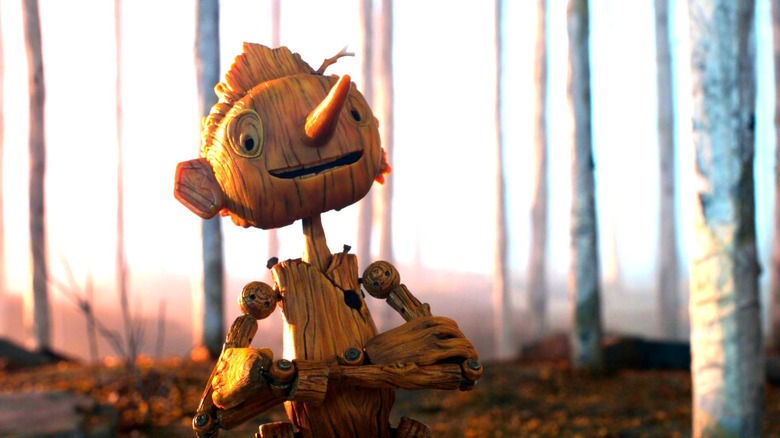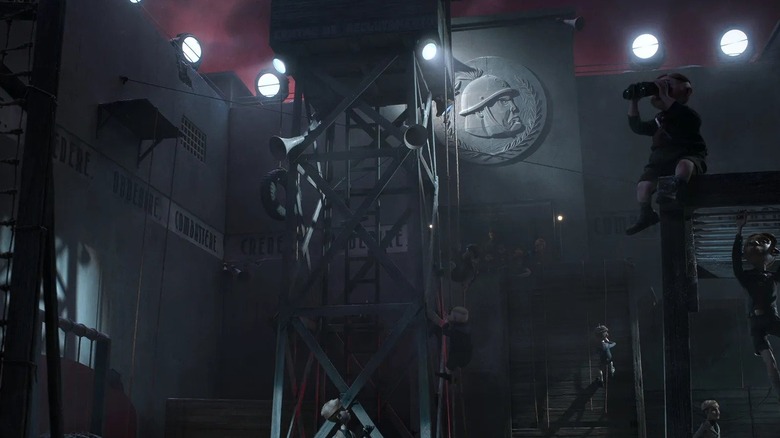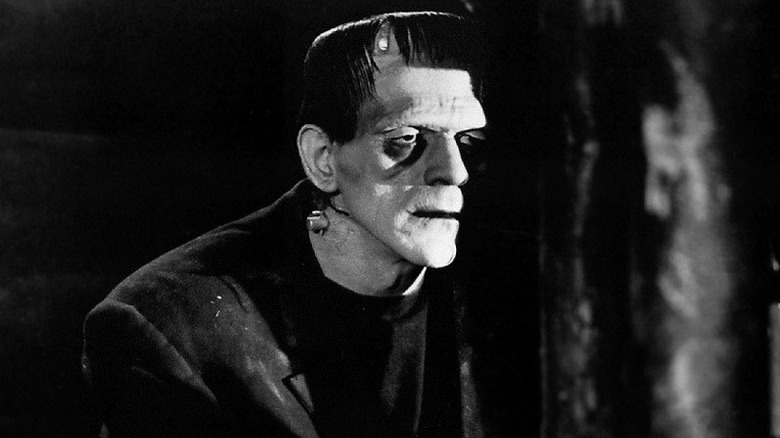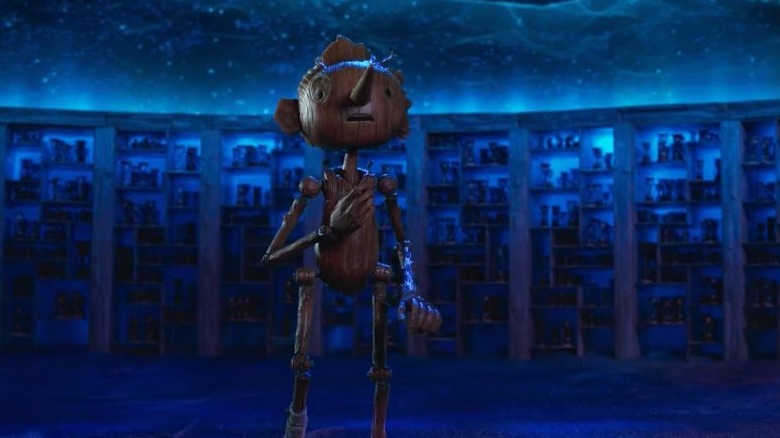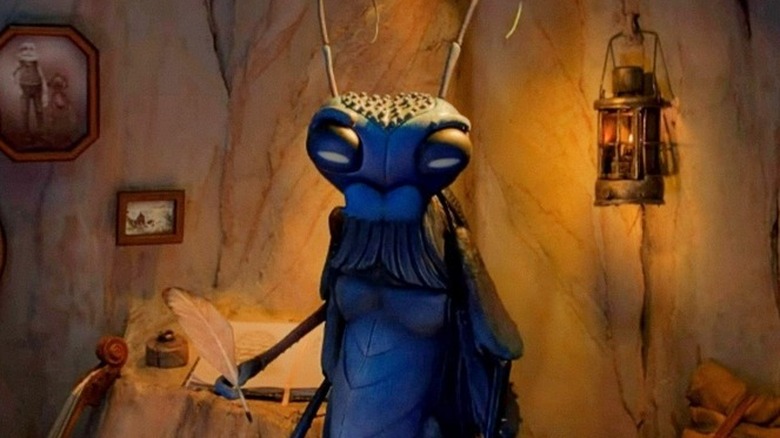The Biggest Differences Between Guillermo Del Toro's Pinocchio And The Original Story
When it comes to talking puppets, it doesn't get more iconic than Pinocchio. The lovable little wooden boy who dreams of becoming real is a household name for fans of children's literature, Disney movies, and general folk tales. Since his creation back in 1883 with Carlo Collodi's "The Adventures of Pinocchio" children's book, this character has become an enduring staple of pop culture thanks to numerous adaptations and interpretations in media.
Most people probably know of Pinocchio from Disney's 1940 adaptation, which was actually the second animated feature ever created by the young studio following the success of 1937's "Snow White and the Seven Dwarfs." This interpretation has gone down as the most well-known version of the character thanks to the film's lush animation and memorably dark moments, as well as the general popularity of Disney animation over the years. But it's not alone as a unique take on Collodi's creation.
There have been countless adaptations of the original story for both film and television since the character was born, with even more cameo appearances in other unrelated pieces of media. From the first silent film adaptation with "The Adventures of Pinocchio" in 1911 to his appearances in modern entertainment such as "Shrek" and "Once Upon a Time," Pinocchio remains a legendary figure who continues to show up in all kinds of stories. It should come as no surprise that there's a new adaptation of the story with Guillermo del Toro's own "Pinocchio," which finds the beloved director of "Hellboy," "Pan's Labyrinth," and "The Shape of Water" taking the story in his own unique direction (alongside co-director Mark Gustafson and co-writer Patrick McHale). Read on to find out all the biggest differences between Guillermo del Toro's "Pinocchio" and the original story.
Del Toro's version takes place in fascist Italy
Fans of the original story and Disney's "Pinocchio" will know that, traditionally, the story is intended to take place in 19th century Italy during roughly the same time period when Carlo Collodi wrote the children's tale. The plot incorporates many elements of the late 1800s which have become iconic features of Pinocchio's journey, such as aspects of commedia dell'arte, contemporary clothing, and old fashioned modes of transportation like wagons. That's why one of the most noticeable changes Guillermo del Toro and company make in their adaptation is changing the setting of "Pinocchio" to a much darker period in Italian history.
This "Pinocchio" isn't set in the picturesque Tuscan countryside of the 19th century, but instead brings audiences to the oppressive and dangerous period of fascist rule of the peninsula during the 1930s (see National Geographic). Del Toro is no stranger to incorporating the dark realities of fascism into fantasy stories — it's exactly what he did with "Pan's Labyrinth," which takes place during the brutal regime of Francisco Franco in Spain. By giving the story of "Pinocchio" this dramatic political backdrop, del Toro draws associations between a puppet like Pinocchio with the puppet-like nature of people following the orders of an authoritarian society.
During an interview with Vanity Fair, del Toro elaborated on this connection, as well as his desire to subvert the original story in new ways. "It's a book full of great invention, but it's also in favor of obeying your parents and being 'a good boy' and all that," he explained. "This [movie] is about finding yourself, and finding your way in the world — not just obeying the commandments that are given to you, but figuring out when they are okay or not."
The feel of stop motion
Guillermo Del Toro's "Pinocchio" is yet another cinematic adaptation of the original 1883 novel, one of many efforts throughout movie history to translate this story from one storytelling medium to another. But this version differentiates itself from all previous attempts to tell the story of Pinocchio by utilizing the bold medium of stop motion rather than traditional 2D or 3D animation like the better-known Disney film.
Apparently, this interpretation of the classic tale has been on Guillermo del Toro's mind for years, and the stop-motion nature of the project was an essential part of his vision. According to a SyFy interview with writer Matthew Robbins, stop-motion was non-negotiable for the director, even if it significantly raised the budget of the film compared to other 2D or CG methods. Fearing the ambitious project would never get made, Robbins tried to talk del Toro into a compromise, but the visionary filmmaker wouldn't budge. "Guillermo said, 'No! No! No! No! It's gotta be stop-motion!'" the writer recalled. "So it never went very far, but I thought, 'Come on!' Years were going by ... I got excited for 30 seconds, but Guillermo stuck to his guns and lo and behold, it's happening."
A different kind of magic
In Carlo Collodi's 1883 novel "The Adventures of Pinocchio," the author creates a truly fantastical world where all sorts of magical creatures exist throughout the Italian countryside. Pinocchio himself is the result of magic brought about when his creator, Geppetto, finds a sentient piece of wood which cries in pain as he tries to carve into it. And there are even more examples of fantastic beasts that are encountered throughout the episodic tale, with Pinocchio coming across a talking cricket, a fairy with turquoise hair, talking animals, shapeshifting spells, and other examples of otherworldly magic.
For his adaptation, Guillermo del Toro wanted to distance the story from some of the more unrealistic magical elements in order to root it as much as possible in reality. Essentially, this version cuts out all examples of magic aside from Pinocchio himself, the talking cricket, and two fairy sisters who oversee the puppet's journey between life and death.
During an interview with Vanity Fair, the director commented on this decision. "I didn't want magical creatures other than the wood spirit that gives him life, and Pinocchio himself," del Toro explained. "I didn't want a talking fox and a talking cat and the magic of transforming him into a donkey. I wanted everything else to feel as close as we can to the real world." This is a significant difference from both the original story and the Disney adaptation, which fully embraced the magical world that Pinocchio inhabited.
Pinocchio is disobedient
Partially related to the film's change of setting to 1930s Italy under the fascist control of Benito Mussolini (played in the film by SpongeBob voice actor Tom Kenny) is a change in the nature of Pinocchio himself. To Guillermo del Toro, the original story is more focused on encouraging children to behave themselves and follow the authority of their parental figures by being honest, trusting, and obedient. In his "Pinocchio," the director wanted to shift away from this in a fundamental way.
Unlike other interpretations of the character, del Toro sees Pinocchio as a rebellious figure whose role is to fight against the unjust society that he's been brought into. This is an alternative perspective on the story which contrasts with the obedient message of previous adaptations. The filmmaker talked about this openly during the press tour for his "Pinocchio" by actively stating his desire to subvert the more traditional moral of the story. "Blind obedience is not a virtue," del Toro told Vanity Fair. "The virtue Pinocchio has is to disobey. At a time when everybody else behaves as a puppet — he doesn't. Those are the interesting things, for me. I don't want to retell the same story. I want to tell it my way and in the way I understand the world."
Pinocchio looks less like a little boy
In pop culture, Pinocchio is deeply associated with the Disney portrayal of the character as a basically human boy but with notable puppet features. But for the most part, this has been the iconic look that's prevailed in pop culture up until this point, despite not being very accurate to the book. For his "Pinocchio," Guillermo del Toro chose to go back to the original depiction of the character for basic inspiration, but he and his team also chose to take their vision in a completely different direction from all previous looks for the puppet.
He brought in renowned artist Gris Grimly to make all new designs for the picture all the way back in 2011 when the project first materialized. Unlike previous looks for the character, del Toro and Grimly's combined style has been imbued into Pinocchio by giving him a more natural and wood-like appearance. The character is much more rugged and unfinished, looking more like a hand-carved piece of wood rather than a fully-formed puppet (understandable, considering that Geppetto is drunk and wracked with grief when he carves him). During an interview with Deadline, del Toro touched on the team's intention to go back to something similar to the original depictions of the character. "What we're trying to do is present a Pinocchio that is more faithful to the take that Collodi wrote," the filmmaker explained. "That is more surreal and slightly darker than what we've seen before."
Del Toro's Pinocchio is a war story
Not only does Guillermo del Toro's new "Pinocchio ” take place during the height of fascism in Italy, it also features the horrifying realities of war which were brought upon the country as a result of imperialism. As a director, del Toro has always been driven to portray the violence inherent in militaristic political systems, a theme that finds its way into his work regardless of the genre or tone he's dealing with. "Pan's Labyrinth," for instance, shows brutal acts of violence through frighteningly real characters like Captain Vidal who represent the inherent evil of fascism as a whole.
One of the most famous plot points of previous Pinocchio stories is his time at Pleasure Island, where the naïve puppet is taken advantage of by the evil carnival Coachman and turned into a donkey for the amusement of strangers. Guillermo del Toro decided to change this entire plotline to something much different by instead having Pinocchio get taken in by government officials who want to use him as a weapon of war. In an interview with Vanity Fair, del Toro explained more about this change. As he summed it up, "He is recruited into the village military camp, because the fascist official in town thinks if this puppet cannot die, it would make the perfect soldier." Although this sounds a bit silly, it totally is in line with the other changes made by the director for this adaptation.
Del Toro was inspired by Frankenstein
Over the years, Carlo Collodi's original story and its many adaptations have come to represent the virtues of telling the truth and being loyal to your family (per The New Yorker). It's also about the idea that what makes you special is on the inside, and that it's unwise to try and change yourself for the sake of others, no matter how much they want you to. While Guillermo del Toro loves the original story, he openly wanted to make his version a counterpoint to the moral philosophy behind it.
Interestingly, del Toro has compared the character of Pinocchio to an unlikely horror icon: Frankenstein. According to Tor, the director compared both stories as being similar in what their principal characters are searching for. "I've always been very intrigued by the links between Pinocchio and Frankenstein," the filmmaker explained. He added, "They are both about a child that is thrown into the world. They are both created by a father who then expects them to figure out what's good, what's bad, the ethics, the morals, love, life, and essentials, on their own. I think that was, for me, childhood. You had to figure it out with your very limited experience." Aside from the fact that Pinocchio has the love of his creator and Mary Shelley's iconic monster gets nothing but contempt from everyone he meets, the two stories do seem to touch on the same philosophical beats.
The vivid color palette sets it apart
A hallmark of Guillermo del Toro's filmmaking style is his usage of a vivid, fantastical color palette to match his even more vivid imagination. Some of his most critically acclaimed films are noted for gorgeously composed and sumptuously lit visuals, and that trademark is on full display in "Pinocchio." According to a piece by StudioBinder, del Toro wears his influences on his sleeve (namely comic books, anime, manga, and horror films) in regards to why he prefers such a juicy range of colors for his cinematography.
Additionally, he has openly looked to the past, with legendary directors like Italy's own Federico Fellini directly inspiring del Toro's approach to filmmaking. According to The CineJournal, he believes that color is a key element to his storytelling ability. "Color gives you the key of the film in the same way that some songs are better in one key than another, and [the keys] define the genre of the song," del Toro explained. It should come as no surprise, then, for fans of "Pinocchio" to be dazzled by the gorgeous color palette of the film, which differs significantly from the look of previous incarnations of the story. Critics have noted that del Toro's "Pinocchio" is a feast for the eyes, with the overwhelmingly positive reviews frequently noting its beautiful visuals.
Everything with the talking cricket
So, let's talk about Jiminy Cricket, a character most people know thanks to the 1940 Disney version of "Pinocchio." In that movie, Jiminy (much more of a tiny little man than anything particularly insectoid) is a consistent presence in the story as a friend and voice of conscience for Pinocchio as he navigates the trials of his journey to become a real boy. This is quite different from the original story, and just as different from del Toro's version of the cricket.
In Collodi's original 1883 book "The Adventures of Pinocchio," this character is only known as "Talking Cricket" and mostly appears for one major scene in which he scolds Pinocchio and is promptly killed as a result. He does later return as a ghost, but it's hard to get past how this unjust cricket homicide is totally absent from most adaptations of the story. Guillermo del Toro differs from both approaches to the talking cricket by giving him a substantial role as a narrator. Known now as Sebastian J. Cricket (voiced by Ewan McGregor), he accompanies Pinocchio while recounting the story to the audience. Though he does travel with Pinocchio inside his wooden head while trying to guide him along (similar to Disney's version), it remains distinct from the original novel by not outright killing him.
